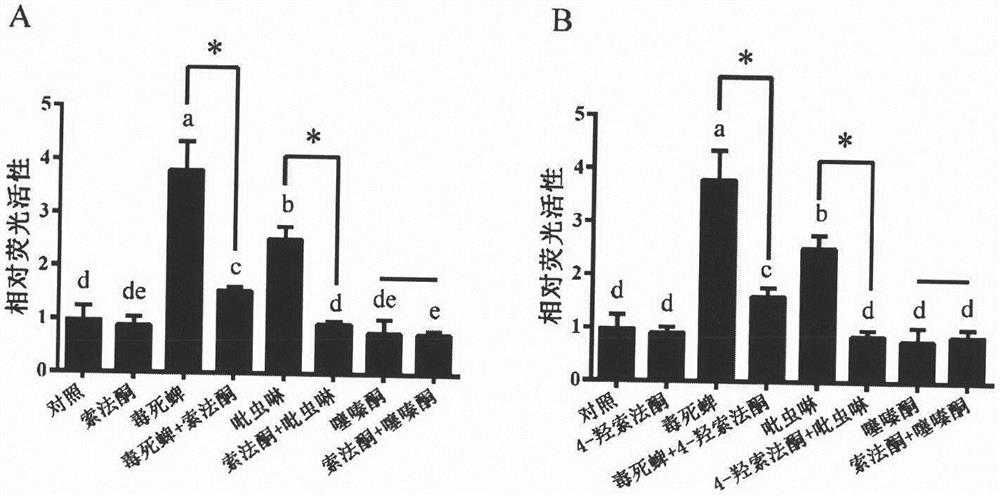New pesticide synergistic technology and application thereof
A gene and cytochrome technology is applied in the field of pesticide synergy in the regulation of the transcription of pest detoxification enzyme genes, and the inhibition of the transcription of pest detoxification enzyme genes, which can solve the problem that resistant pests have no cure, cannot solve the problem of multi-drug resistance, and reduce the Detoxification and metabolism of harmful organisms, etc., to achieve a wide range of synergistic effects
- Summary
- Abstract
- Description
- Claims
- Application Information
AI Technical Summary
Problems solved by technology
Method used
Image
Examples
Embodiment 1
[0040] Example 1: Cloning of the upstream regulatory sequence of the CYP gene of beet armyworm and brown planthopper
[0041] RNA extraction kits were used to extract total RNA from brown planthopper and beet armyworm respectively, and cDNA was obtained by reverse transcription, and then using cDNA as a template, PCR amplification was performed using primers for the upstream regulatory sequence of the CYP gene, and the reaction system included 12.5 μL 2× 1 μL each of Taq Mix and upstream and downstream primers, add ddH 2 0 to 25 μL. The amplification program was: pre-denaturation at 94°C for 3 min, denaturation at 94°C for 30 s, annealing at 55°C for 30 s, extension at 72°C for 2 min, and after 30 cycles, extension at 72°C for 10 min. After PCR product recovery and pMD 19 -T vector ligation, the ligation product was transformed into Escherichia coli DH 5α competent cells, positive clones were screened by blue and white spots, positive clones were sent for sequencing for veri...
Embodiment 2
[0042] Example 2: Construction of a fluorescent reporter plasmid
[0043] Select Xhol I and hind III restriction sites on the fluorescent reporter plasmid PGL3-Basic, and perform double digestion to linearize them. The double restriction reaction system includes: Xhol I 1 μL, Hind III 1 μL, 10×fast Cut buffer 5 μL, PGL3-Basic plasmid 1 μg, make up to 50 μL with double distilled water, and then react at 37°C for about 2 hours to obtain a linearized plasmid. Design specific primers according to the instruction manual of CloneExpress II One Step Cloning Kit, and add homologous sequences at the end of the linearized PGL3 vector to the 5' end of the original specific primers, that is, two restriction site sequences of Xhol I and hind III to form a new the amplification primers. Then, the CYP gene upstream regulatory sequence (SEQ ID NO.1, SEQ ID NO.2, SEQ ID NO.3, SEQ ID NO.4, SEQ ID NO.5, SEQ ID NO.6 cloned in embodiment one , SEQ ID NO.7, SEQ ID NO.8, SEQ ID NO.9 and SEQ ID NO....
Embodiment 3
[0044] Example three: transfected cells
[0045] Place Sf9 cells in a biochemical incubator at 27°C for culture, add fetal bovine serum with a final content of 5% to the SF9-900 II SFM medium as the cell culture medium, and passage the cells every three days to ensure the viability of the cells. Sf9 cells cultured for about 2 days and whose viability was above 95% were used for the experiment. Gently aspirate the culture medium in the culture dish, use a pipette gun to draw 1mL of fresh medium containing 5% serum, gently blow and suspend the adherent cells, and transfer the blown cells to a 50mL centrifuge tube, take 10 μL of cell solution was thoroughly mixed with 10 μL of Coomassie Brilliant Blue and added to a cell counting plate for cell counting. Calculate the amount of cells to be added according to the cell counting results, and reduce the cell concentration in the centrifuge tube to 8×10 5 A / mL or so. In a 24-well cell plate, add 500 μL per well containing 4×10 5 T...
PUM
 Login to View More
Login to View More Abstract
Description
Claims
Application Information
 Login to View More
Login to View More - R&D
- Intellectual Property
- Life Sciences
- Materials
- Tech Scout
- Unparalleled Data Quality
- Higher Quality Content
- 60% Fewer Hallucinations
Browse by: Latest US Patents, China's latest patents, Technical Efficacy Thesaurus, Application Domain, Technology Topic, Popular Technical Reports.
© 2025 PatSnap. All rights reserved.Legal|Privacy policy|Modern Slavery Act Transparency Statement|Sitemap|About US| Contact US: help@patsnap.com



